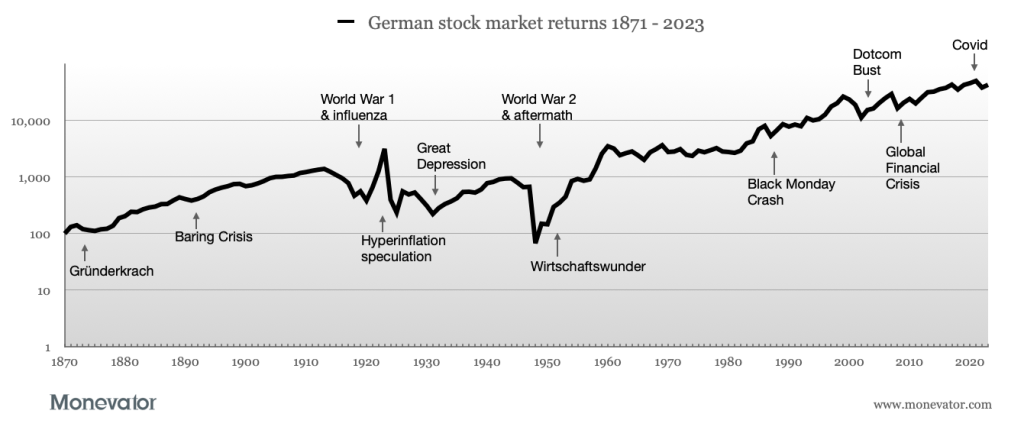
The recent commodities bear market – 2008 to 2020 – was like watching a faraway, failed state descend into chaos. Hard to understand, it went on for years, and all you really knew was that you didn’t want to go there. Hence I’d guess that many Monevator readers instinctively recoil from the very idea of commodities investing.
But ongoing research and long-term data pieced together by multiple teams of investing academics suggests that commodities have been unfairly tarnished.
What happened to the asset class in that slump is most likely explained by a terrible sequence of returns. Bad luck for commodity investors, but a perfectly standard manifestation of investing risk.
If that thesis is correct, then by ruling out commodities we make the same mistake as a risk-shy investor who has a lifelong aversion to equities because they came of age during the Great Depression.
The bigger picture – filled in by 150 years worth of investment returns – is that broad commodities deliver excellent results over time, can diversify equity / bond portfolios, and boast some inflation-hedging capability, too.
Please read our commodities investing explainer for our intro to the asset class, how it works, and the drivers of return that make it profitable.
The ghost of futures past
The following long-run UK returns chart shows why commodities futures are worth a second look:
Data from AQR1, Summerhaven2, JST Macrohistory3, and FTSE Russell. May 2023.
Since 1870, equal-weighted commodities have delivered a surprisingly good annualised real return of 4.3%.
Meanwhile, UK equities paced ahead with a 5.3% return, while government bonds brought up the rear on 1.4%.
Investing returns sidebar – All returns quoted in this piece are real annualised total returns. That is, they’re the average annual return (accounting for gains and losses) realised in a given time period. These returns include the impact of reinvested dividends and interest, but strip out the vanity growth delivered by inflation that does nothing to boost your spending power. Commodities dollar returns have been converted to GBP4.
Equities’ stronger returns mean we could forget about commodities if all that was happening was that shares and commodities rose and fell in synchronicity.
But the chart above also shows that commodities wax and wane to a different beat.
They’re highly volatile, but the fact that they often perform when equities (and bonds) falter is central to the pro-commodities case
They’re also a potent diversifier because the record shows that they’ve delivered superior long-term returns compared to gold, cash, or bonds.
Reality check
Before we go any further, I have to deliver a reality check that takes the gloss off these results. (Although with that said it doesn’t undermine the nub of the issue: that commodities generate good returns – and otherwise unattainable diversification benefits – for a passive investor.)
The 150-year index shown above enables us to see the long-term pattern of commodity returns. But that index is very difficult to actually invest in.
That’s because the Summerhaven and AQR research teams behind the historical data reconstituted it as an equal-weighted commodities futures index.
This is a standard academic practice. It apportions the same weighting to every commodity futures contract included in the index.
However there’s currently only one broad commodities ETF that tracks an equal-weighted index – and it excludes agricultural products.
The majority of commodity indices weight their constituents by world production quantities and / or trading volume.
This method is intended to represent the global economic significance of each commodity type. (Just as equity indices represent firms according to their market capitalisation.)
The issue is that production and liquidity-weighted indices typically underperform their historical equal-weighted counterparts.
So to ensure we stay firmly grounded in the real world, I’ll only use data from historically investable commodities indices for the rest of these articles.
Happily we have just such an index going back to 1933, thanks to the forensic efforts of Summerhaven’s research team. They published the data alongside their paper The First Commodity Futures Index of 1933.
Their reconstruction of the Dow Jones Commodity Index can be directly linked to the contemporary Bloomberg Commodity Index, which is tracked by some of the largest ETFs in the space today.
Do long-term investable commodity returns stack up?
Thankfully, still yes. Here’s the chart:
Data from Summerhaven5, S&P GSCI TR, BCOM TR, A Century of UK Economic Trends, and FTSE Russell. May 2023.
The annualised return of commodities is 4.5% versus 5.5% for UK equities over this 89-year timeframe. Bonds dawdled along at a paltry 0.85%.
Happily, aside from confirming that investable commodities deliver very handy returns, the chart also demonstrates that commodities often soared when equities stumbled.
You can see commodities spike as equities sold off during World War Two, again in the early 1950s, and incredibly so in the stagflationary ’70s.
The same happens in reverse, too. Equities did the heavy lifting when commodities crashed in the aftermath of the Credit Crunch.
How do commodities help as a portfolio diversifier?
The next chart shows how the main diversifying asset classes performed in years when equities were down, from 1934 to 2022.
Even at a glance, the cyan bars tell us that commodities sometimes spectacularly outperform everything else.
That’s true in 1939 and in the post-war years of 1947 and 1949. It happens again in 1973, during the first leg of the UK’s worst-ever stock market crash, the opening innings of the dotcom crash in 2000, and most recently in 2022.
There are also times when commodities are the only asset class that registers a positive return, while the others burrow into the ground.
Indeed, commodities are the best asset in the portfolio 32% of the time. That’s a record only bested by cash’s 34% score. And cash earns pitiful long-term returns by comparison.
Yet the fact remains that commodities can be a difficult bedfellow. They made portfolio returns worse in 42% of the years examined in our chart above. (Of course this also means they improved portfolio returns 58% of the time…)
Commodities won’t always bail you out. Sometimes they’ll make you rue the day. But there have been crises when they were the only thing that worked.
We’ll examine how much commodities improve overall portfolio performance across the entire 89-year timeframe in a future post in this series.
Commodity correlations
A correlations asset class matrix can help us assess the diversification benefit of commodities over different periods. An effective diversifier registers low positive or negative numbers against the other main asset classes.
Asset class returns correlations: annual returns 1934-2022 (inflation- adjusted)
Commodities
UK equities
Gilts
Cash
Gold
Commodities
1
-0.11
-0.16
0.05
0.37
UK equities
-0.11
1
0.39
0.08
-0.21
Gilts
-0.16
0.39
1
0.29
-0.05
Cash
0.05
0.08
0.29
1
0.04
Gold
0.37
-0.21
-0.05
0.04
1
Gold data from The London Bullion Market Association and Measuring Worth. Cash is UK Treasury Bills data from JST Macrohistory and JP Morgan Asset Management. Other assets as per previous charts. May 2023.
Quick correlation recap:
1 = Perfect positive correlation: when one asset goes up so does the other
0 = Zero correlation: the two assets being measured have no influence upon each other
-1 = Perfect negative correlation: when one asset goes up, the other goes down
On this measure, commodities look like an excellent diversifier. The asset’s slightly negative correlation with equities and gilts means that it will sometimes spike when they stall or fall.
Of course this also means that commodities can hold a portfolio back when shares and bonds are steaming ahead. But on balance, the historical record shows the asset class is a net positive.
One of the exciting things about these correlation numbers is you rarely see other assets produce a combination of numbers that gel so well with equities and bonds and deliver strong long-run returns.
By way of contrast, gold’s weak results over extended time periods (and the lack of a strong economic rationale for decent expected returns in the future) make me nervous about owning significant quantities of the yellow metal.
Most of us buy into the idea of equity and bond diversification – even though they’re relatively highly correlated, and thus likely to be less effective diversifiers at times.
Once again, it’s the combination of strong positive returns and low correlations with equities and bonds that make commodities worthy of serious consideration.
2008-2020 be damned!
Well, maybe…
Commodity drawdowns and crashes
I still can’t help being scared by that horrendous -66% commodities drawdown lasting from June 2008 to April 2020.
Other lowlights include a 20-year bear market that dragged on from 1951 to 1971. And another -62% beasting that ravaged commodities from the end of 1974 to the beginning of 1982.
Overall there are several lost decades to wince at. Especially if we go back to the 1870s via the equal-weighted index.
By the way, don’t forget that these figures are real returns. Most commentators will talk about crashes and bear market recoveries in nominal terms – a much gentler standard.
However it’s my duty to tell you that commodities investing is no easy ride. Although historically they’ve been a touch less volatile than equities.
On that note, it’s important to remember that all this and worse has also happened to the other asset classes we stake our future wealth on.
UK equities caved -79% from 1972 to 1974, for instance. The UK’s worst bond market crash also plunged to -79% depths, from 1935 to 1974. Gold suffered a near 20-year bear market between 1980 and 1999.
Nothing is ‘safe’.
If commodities still give you the willies, I can only say I’m right there with you.
They’re an unfamiliar asset class that works in an arcane way. And we’ve just lived through one of the worst commodities drawdowns on record.
None of that helps my rational self override my emotional self.
Which begs a serious question…
Are commodities a broken asset class?
Was the 2008 to 2020 losing streak just a bad bear market, or did something fundamentally change to impair the future fortunes of commodities?
To answer this question, let’s bring in the big guns. Namely the venerable financial academics Dimson, Marsh and Staunton (hereafter DMS).
DMS looked at precisely this question as part of their commodities investing chapter in the Credit Suisse Global Investment Returns Yearbook 2023.
A particular concern is that the launch of commodity index trackers shortly before the Global Financial Crisis – and the concomitant flood of institutional investment capital – might have led to a permanent reduction in the historical advantages of the asset class.
DMS highlighted three possible dangers associated with the ‘financialization’ of the relatively small commodities market:
First, inflows could have lowered the risk premium through the increased competition in the provision of insurance to hedgers. Second, because institutional investors hold portfolios of commodities and their allocation to commodities competes to some extent with that to other assets, their activities might increase the correlation between individual futures, and between futures and other asset classes. Finally, passive index investments might weaken the link between futures prices and fundamentals.
However, DMS then go on to survey the work of other researchers who’ve examined this question and say:
The authors conclude that, despite the high growth in commodity markets during this decade, the proportion of hedgers and speculators was broadly constant. Nor, in terms of risk and return, was this decade significantly different from the longer historical experience. Correlations between commodities rose, then fell again. The authors attribute this to the Global Financial Crisis, not financialization.
Citing additional evidence, DMS judge that:
It would seem quite wrong, therefore, to conclude that the risk premium from futures had disappeared simply because of the Global Financial Crisis drawdown in commodity futures that followed the publication of GR’s [Gorton and Rouwenhorst] research. This was a disinflationary and low inflation period, and, as we will see below, these are challenging conditions for commodity futures.
DMS go on to show that commodities tend to perform poorly during recessions and disinflationary periods, concluding:
The disinflationary decade following the crisis was a very difficult time for commodities. Many institutions capitulated, reducing or removing their commodity positions – before they turned useful again in 2021/22. It is harder for investors to stay the course in commodities than equities amid a comparable drawdown, given that commodities are less ‘conventional’. This can be a typical fate for a good diversifying asset.
Indeed, the academic trio believe that the commodities risk premium remains alive and well:
What risk premium should we expect from a long-run investment in a portfolio of collateralized futures? Ilmanen (2022) concludes that the best long-term, forward-looking estimate is the historical premium. He suggests that “a constant premium of some 3% over cash seems appropriate for a diversified commodity portfolio – though not for single commodities!”
Other researchers float that 3% excess return figure too as the average long-term return you would hope to gain over and above the interest rate earned on cash in the bank.
Vanguard’s 2023 commodities paper for instance employs an expected returns model to draw in data beyond the historical record. It proposes a highly finessed base-case estimate of a 2.85% future expected excess return.
Though it then hedges its bets by citing a range anywhere between 0.5% to 3%.
Where does this leave us?
It’s because I think we should all hedge our bets that I’m writing this commodities series in the first place.
I want to evaluate the evidence for and against as well as I can, especially as it’s an asset class with enough ifs, buts, and maybes to fill a comedy of manners.
Perhaps we need to move on from considering the strengths and weaknesses of commodities in isolation? After all, what really matters is their potential contribution as part of our properly diversified portfolios.
Let’s get to that in part three.
Take it steady,
The Accumulator
Levine, Ooi, Richardson, and Sasseville. “Commodities for the Long Run.” FAJ, 2018.Bhardwaj, Geetesh and Janardanan, Rajkumar and Rouwenhorst, K. Geert. 2019. “The Commodity Futures Risk Premium: 1871–2018.”Òscar Jordà, Katharina Knoll, Dmitry Kuvshinov, Moritz Schularick, and Alan M. Taylor. 2019. “The Rate of Return on Everything, 1870–2015.” Quarterly Journal of Economics, 134(3), 1225-1298.British Pound SterlingBhardwaj, Geetesh and Janardanan, Rajkumar and Rouwenhorst, K. Geert, “The First Commodity Futures Index of 1933,” Journal of Commodity Markets, 2020.
The post Why commodities belong in your portfolio appeared first on Monevator.



